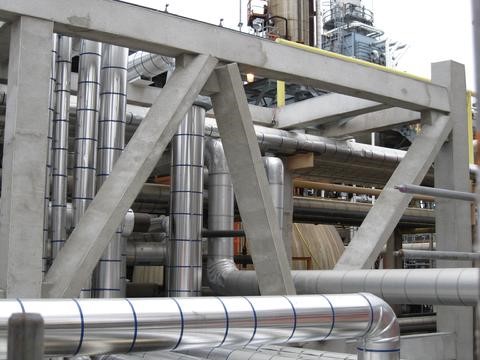In part 1 of this series we explored the danger to people and equipment of failing fireproofing. In part 2 of this series, we will focus on different types of fireproofing systems.
Question 2: What are the advantages and disadvantages of different types of fireproofing?
There are three primary passive fireproofing systems used in industrial facilities, normal weight concrete, lightweight concrete, and intumescent fireproofing. Each system has relative pros and cons and can be effectively and cost-efficiently used depending on the environment the structure is in, the function of the structure, its intended lifespan, and what the long-term maintenance commitment is.
Normal weight
Normal weight concrete fireproofing (around 150 pounds per cubic foot) is similar to concrete that would be used for structural applications but has a different mix design. It has the advantages of being the most protective fireproofing for the underlying structural steel by passivating the steel. It is also commonly available, long-lasting, durable, easy to maintain, and many craftsmen are familiar with it and its application. The primary disadvantage of normal weight concrete is that it’s heavy.
Lightweight concrete
Light weight concrete fireproofing is a commercially available product (not ready-mix) that is less common than normal weight fireproofing and typically weighs less than 75 pounds per cubic foot. Its primary advantages are that it is lighter weight (so reduces overall load), has higher thermal resistance than normal weight concrete, and is easy to apply with spray or trowel applications being the most common. However, the material is porous, allowing moisture to easily get to the underlying steel so where it is used needs to be highly considered. It also does not typically have the impact resistance of normal weight concrete so there can be durability concerns. These disadvantages limit where it should be used and requires more frequent and expensive maintenance.
Intumescent epoxy fireproofing
Intumescent epoxy fireproofing is a novel material that expands when heated, protecting the underlying steel. Its primary advantage is that it is very light weight (around 10% to 40% that of normal weight concrete) and less bulky than concrete fireproofing, making it ideal for modular and offshore structures. However, it is less commonly available and can be quite difficult to apply correctly so typically requires specialized and certified installers. If you are considering this method it’s important to understand if the installer is certified. This method is known to have durability and costly maintenance concerns throughout its lifespan.
Brindley Engineering has an extensive background in evaluating various types of fireproofing products and systems at facilities in many geographic environments and uses, all over the world. We are a neutral party that does not represent any material provider and we are routinely requested to analyze and recommend products and systems for our Clients with their best-interest in mind. With the ever-increasing number of proprietary products being marketed to facilities, selecting the correct systems to use are critical to controlling cost and providing the safety and fire-resistance the facility expects over its required lifespan.
Talk to a Brindley Engineer Team member today ntriandafilou@brindleyengineering.com!
- Click here to read Part 1 of 5 Essential Fireproofing Questions
- Click here to read Part 3 of 5 Essential Fireproofing Questions
- Click here to read Part 4 of 5 Essential Fireproofing Questions
- Click here to read Part 5 of 5 Essential Fireproofing Questions




0 Comments